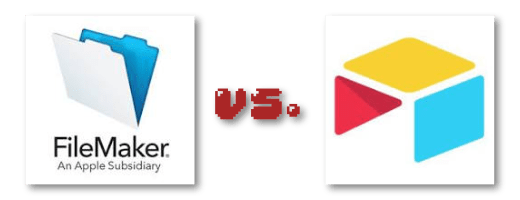“Do you even Airtable, bruh”?

FileMaker, a wholly-owned subsidiary of Apple, is the venerable development platform that’s been improving business efficiency with custom software for more than 30 years. Airtable is a modern database/spreadsheet hybrid, first released in 2012, that’s been well-received in some of the same workplace environments in which FileMaker shines. There is significant overlap in the abilities of both FileMaker and Airtable, so which should you choose, and why?
Data Driven UI
Both platforms are built for storing data. Neither is a true development platform in which you can build anything you want; both FileMaker and Airtable are effectively data-driven platforms.
FileMaker offers more flexibility in what it can accomplish, not only with the data, but with the user interface as well. It requires you to design screen layouts from scratch in order for users to see and manipulate data, but it has a full scripting engine that can support custom functionality.
Airtable, like many other productivity tools, offers a basic set of pre-built screens and features that can be turned on or off, configured, and customized to a limited extent. However, these tools don’t offer full and complete customization, except in data modeling. This is, in some respects, a feature. If you don’t want to fuss with creating a UI and writing scripts, Airtable is ready-made for you, and does have some great UI on offer.
However, if you have very specific data entry needs or require a more full-featured front end that can operate in specific ways, FileMaker’s ability to provide a custom-designed interface and feature set is the way to go.
Airtable has a free tier, and then a per-user cost that graduates into several tiers, depending on the number of records and the amount of cloud storage required. For small database projects (1200 records or less), Airtable’s free tier is quite good. Some of the extra bells and whistles (which they call “blocks”) are not included in the free tier, but definitely add some cool functionality. FileMaker has no free tier, but the per-user cost is actually lower than Airtable’s, and there are no limits on the number of records you can have.
It’s simplest to launch a cloud-based system on Airtable, which only involves signing up and logging onto their website. FileMaker, on the other hand, requires you to set up your own server, or use FileMaker cloud (which is significantly easier, but still has some learning curve). It also relies on client applications to be installed on either a desktop or an iOS device, unless you decide to build a system using WebDirect for browser-only clients. This adds a layer of complexity for users that they may not be familiar with. Since so many productivity applications are now cloud-based web apps, making users install client software and connect to a server can seem a bit old-fashioned and clunky, although this should by no means be a deal-breaker.
Comparison
FileMaker offers infinite flexibility and full customization of your data model, user interface, and deployment. It’s well-suited to small and medium-sized organizations where flexibility, security, and rapid development of custom features and reporting is important. While FileMaker offers a great deal of power and flexibility, it can also be used and customized by novice users. The mobile component is very robust, and using FileMaker Go, you can access native hardware features of iOS devices such as cameras, sensors, GPS, etc. The power and flexibility of the FileMaker platform, however, means that adding robust features or integrations with external data sources and APIs can be complex and require some developer expertise to accomplish.
Airtable is easy to use and deploy across organizations, and has many ready-made features that modern users may have come to expect in their productivity software. Built-in UI conventions like record sorting, filtering, and commenting, sharing of data, calendar and kanban views, and easy integration with other systems like Zapier, Slack, Twilio, and more makes Airtable a very capable database system. The Airtable app for mobile devices automatically presents your data in responsive web style, although it doesn’t have true interoperability with device hardware. The limits on Airtable’s flexibility and customization may hamper the ability of certain organizations to fully utilize their data, but Airtable’s ease of customization may be a big plus for organizations that don’t have a budget for professional software developers.
So, which one do I use?
FileMaker wins if you need full UI flexibility, an iOS app that can interact with hardware features (like GPS, device sensors, barcode scanning, signature capture), complex data modeling and analysis, integration with outside data sources, or high security systems with data protection and encryption. FileMaker can also begin with a simple system that can expand almost infinitely as your needs dictate. And, if necessary, you can call on a large pool of professional developers to assist with building out exactly what you need.
Airtable is perfect if your users can almost get by with just a spreadsheet, but need more robust data modeling, collaboration, and communication. If you use a lot of outside productivity services that can connect to Zapier or IFTTT, then Airtable makes it very easy to integrate them with your data. And if your development budget is restricted or non-existent, then what you sacrifice in flexibility, you gain in ease of customization (such as it is). It’s a very modern and easy-to-use data system.
What do you think?
*This article was originally written for AppWorks, which has since joined Direct Impact Solutions. This article is intended for informative purposes only. To the best of our knowledge, this information is accurate as of the date of publication.
